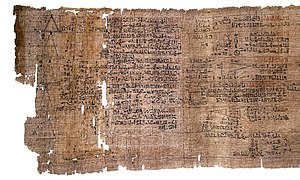
Back بردية ريند الرياضية Arabic Papiru d'Ahmes AST Papir de Rhind Catalan Papyrus Rhind German Papiruso de Rhind Esperanto Papiro de Ahmes Spanish Ahmesen papiroa Basque پاپیروس ریاضی ریند Persian Rhindin papyrus Finnish Papyrus Rhind French
| Rhind Mathematical Papyrus | |
|---|---|
| British Museum, London | |
 A portion of the Rhind Papyrus | |
| Date | Second Intermediate Period of Egypt |
| Place of origin | Thebes |
| Language(s) | Egyptian (Hieratic) |
| Size | First section (BM 10057 ): · Length: 295.5 cm (116.3 in) · Width: 32 cm (13 in) Second section (BM 10058 ): · Length: 199.5 cm (78.5 in) · Width: 32 cm (13 in) |
The Rhind Mathematical Papyrus (RMP; also designated as papyrus British Museum 10057 and pBM 10058) is one of the best known examples of ancient Egyptian mathematics. It is named after Alexander Henry Rhind, a Scottish antiquarian, who purchased the papyrus in 1858 in Luxor, Egypt; it was apparently found during illegal excavations in or near the Ramesseum. It dates to around 1550 BC.[1] The British Museum, where the majority of the papyrus is now kept, acquired it in 1865 along with the Egyptian Mathematical Leather Roll, also owned by Henry Rhind.[2] There are a few small fragments held by the Brooklyn Museum in New York City[3][4] and an 18 cm (7.1 in) central section is missing. It is one of the two well-known Mathematical Papyri along with the Moscow Mathematical Papyrus. The Rhind Papyrus is larger than the Moscow Mathematical Papyrus, while the latter is older.[3]
The Rhind Mathematical Papyrus dates to the Second Intermediate Period of Egypt. It was copied by the scribe Ahmes (i.e., Ahmose; Ahmes is an older transcription favoured by historians of mathematics), from a now-lost text from the reign of king Amenemhat III (12th dynasty). Written in the hieratic script, this Egyptian manuscript is 33 cm (13 in) tall and consists of multiple parts which in total make it over 5 m (16 ft) long. The papyrus began to be transliterated and mathematically translated in the late 19th century. The mathematical translation aspect remains incomplete in several respects. The document is dated to Year 33 of the Hyksos king Apophis and also contains a separate later historical note on its verso likely dating from the period ("Year 11") of his successor, Khamudi.[5]
In the opening paragraphs of the papyrus, Ahmes presents the papyrus as giving "Accurate reckoning for inquiring into things, and the knowledge of all things, mysteries ... all secrets". He continues with:
This book was copied in regnal year 33, month 4 of Akhet, under the majesty of the King of Upper and Lower Egypt, Awserre, given life, from an ancient copy made in the time of the King of Upper and Lower Egypt Nimaatre. The scribe Ahmose writes this copy.[2]
Several books and articles about the Rhind Mathematical Papyrus have been published, and a handful of these stand out.[3] The Rhind Papyrus was published in 1923 by Peet and contains a discussion of the text that followed Griffith's Book I, II and III outline.[6] Chace published a compendium in 1927–29 which included photographs of the text.[7] A more recent overview of the Rhind Papyrus was published in 1987 by Robins and Shute.
- ^ "The Rhind Mathematical Papyrus". The British Museum. Retrieved 2022-12-21.
- ^ a b Clagett, Marshall (1999). Ancient Egyptian Science, A Source Book. Memoirs of the American Philosophical Society. Vol. Three: Ancient Egyptian Mathematics. American Philosophical Society. ISBN 978-0-87169-232-0.
- ^ a b c Spalinger, Anthony (1990). "The Rhind Mathematical Papyrus as a Historical Document". Studien zur Altägyptischen Kultur. 17. Helmut Buske Verlag: 295–337. JSTOR 25150159.
- ^ "Collections: Egyptian, Classical, Ancient Near Eastern Art: Fragments of Rhind Mathematical Papyrus". Brooklyn Museum. Retrieved November 1, 2012.
- ^ cf. Schneider, Thomas (2006). "The Relative Chronology of the Middle Kingdom and the Hyksos Period (Dyns. 12–17)". In Hornung, Erik; Krauss, Rolf; Warburton, David (eds.). Ancient Egyptian Chronology. Handbook of Oriental Studies. Brill. pp. 194–195. ISBN 9789004113855.
- ^ Peet, Thomas Eric (1923). The Rhind Mathematical Papyrus, British Museum 10057 and 10058. London: The University Press of Liverpool limited and Hodder & Stoughton limited.
- ^ Chace, Arnold Buffum (1979) [1927–29]. The Rhind Mathematical Papyrus: Free Translation and Commentary with Selected Photographs, Translations, Transliterations and Literal Translations. Classics in Mathematics Education. Vol. 8. 2 vols (Reston: National Council of Teachers of Mathematics Reprinted ed.). Oberlin: Mathematical Association of America. ISBN 0-87353-133-7.
© MMXXIII Rich X Search. We shall prevail. All rights reserved. Rich X Search